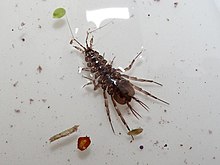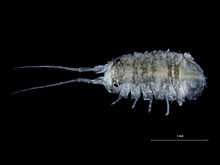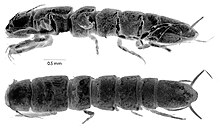Asellota
| Asellota | ||||||||||||
|---|---|---|---|---|---|---|---|---|---|---|---|---|

Water louse ( Asellus aquaticus ) |
||||||||||||
| Systematics | ||||||||||||
|
||||||||||||
| Scientific name | ||||||||||||
| Asellota | ||||||||||||
| Latreille , 1802 |

The Asellota are a subordination of the woodlice (Isopoda). Their representatives live both in fresh water and in the sea, where they can be found on the coasts, but also in the deep sea up to a depth of 10,000 meters.
features
The first antennae are short, single-branched, the second antennae are long and multi-link. Unlike most other crustaceans, the head does not have a rostrum , nor is there a carapace . There are two complex eyes , but one unpaired nauplius eye is missing in the adult stage. With the cave shapes and many deep sea shapes. Six to seven pairs of peraeopods and five pairs of pleopods are present. The first two pairs of pleopods are heavily modified in males and are used for sperm transfer, while the first pair is missing in females.
A striking feature of the Asellota is the merging of some or all of the segments of the abdomen (pleons) with the telson into a large pleotelson that carries paired uropods . The free segments of the pleon, i.e. the first three pleonites at most, are narrow and ring-shaped.
Some deep-sea species have very long striding legs and antennae that give them a spider-like appearance. In the Munnopsidae family , for example, the second antennae as well as some of the front pairs of peraeopods reach a multiple of the body length. In some Munnopsidae, the fifth to seventh thoracic segment together with the pleon forms a so-called natosoma. This is curved upwards and is the starting point for enlarged muscles that are used for swimming with the rear striding legs. The Ischnomesidae have an extremely elongated fifth peraeonite.
distribution
The species of the Asellota are distributed worldwide. The marine Asellota are found in both the Atlantic and the Pacific . Macrostylis galatheae is known from the Philippinengraben , which contains one of the deepest sea places with the Galatheatief . Around 60% of the species described so far live in the deep sea.
Systematics
There are currently six higher-level groups of the Asellota, but the division is temporary in some parts. New forms that require a taxonomic classification are constantly becoming known from the deep sea. Superfamilies, families and selected species:
- Superfamily Aselloidea Latreille, 1802 (freshwater species)
-
Asellidae Rafinesque, 1815
- Cave isopod ( Proasellus cavaticus )
- Water louse ( Asellus aquaticus )
- Stenasellidae Dudich, 1924
-
Asellidae Rafinesque, 1815
- Superfamily Gnathostenetroidoidea Kussakin, 1967 (in shallow marine water)
- Family Gnathostenetroididae Kussakin, 1967 and Gnathostenetroidae Fresi, Idato & Scipione, 1980
- Family Protojaniridae Fresi, Idato & Scipione, 1980
- Superfamily Janiroidea Sars, 1897
- Family Acanthaspidiidae Menzies, 1962
- Family Dendrotionidae Vanhöffen, 1914
- Family Desmosomatidae GO Sars, 1897
- Family Echinothambematidae Menzies, 1956
- Family Haplomunnidae Wilson, 1976
- Family Haploniscidae Hansen, 1916
- Ilyarachnidae Hansen family , 1916
- Ischnomesidae Hansen family , 1916
- Family Janirellidae Menzies, 1956
- Family Janiridae Sars, 1897
- Jaera albifrons (native to the North and Baltic Seas )
- Jaera sarsi (tobe foundin the Danube region )
- Family Joeropsididae Nordenstam, 1933
- Katianiridae Svavarsson family , 1987
- Family Macrostylidae Hansen, 1916
- Macrostylis galatheae (in the Philippinengraben)
- Macrostylis uniformis (in the Weddell Sea ( Antarctic Circle ))
- Family Mesosignidae Schultz, 1969
- Mictosomatidae Wolff family , 1965
- Family Munnidae Sars, 1897
- Family Munnopsidae Lilljeborg, 1864
- Subfamily Acanthocopinae Wolff, 1962
- Subfamily Bathyopsurinae Wolff, 1962
- Subfamily Betamorphinae Kussakin, 2003
- Subfamily Eurycopinae Hansen, 1916
- Genus Tytthocope Wilson & Hessler, 1981
- Tytthocope sulcifrons (Barnard, 1920)
- Tytthocope divae Malyutina & Brandt, 2014
- Genus Tytthocope Wilson & Hessler, 1981
- Subfamily Ilyarachninae Hansen, 1916
- Subfamily Lipomerinae Tattersall, 1905
- Subfamily Munnopsinae Lilljeborg, 1864
- Subfamily Storthyngurinae Kussakin, 2003
- Subfamily Syneurycopinae Wolff, 1962
- Family Nannoniscidae Hansen, 1916
- Family Paramunnidae Vanhöffen, 1914
- Family Pleurocopidae Fresi & Schiecke, 1972
- Family Santiidae Wilson, 1987
- Family Thambematidae Stebbing, 1913
- Family Xenosellidae Just, 2005
- Superfamily Stenetrioidea Hansen, 1905
- Family Pseudojaniridae Wilson, 1986
- Family Stenetriidae Hansen, 1905
- Superfamily Urstyloidea Riehl, Wilson & Malyutina, 2014
- Family Urstylidae Riehl, Wilson & Malyutina, 2014
- Asellota incertae sedis
- Microparasellidae family Karaman, 1933
- Vermectiadidae family Just & Poore, 1992
Individual evidence
- ↑ a b George DF Wilson: Definition of the Asellota ( Memento of the original from March 5, 2014 in the Internet Archive ) Info: The archive link was inserted automatically and has not yet been checked. Please check the original and archive link according to the instructions and then remove this notice. , accessed March 28, 2014
- ^ JK Lowry: Asellota . In: Crustacea, the Higher Taxa: Description, Identification, and Information Retrieval. Version dated October 2, 1999, accessed March 27, 2014
- ^ A b George DF Wilson: Isopod Crustaceans - Suborder Asellota - Superfamily Janiroidea , accessed March 28, 2014
- ^ WoRMS: Asellota Latreille, 1802 . In: M. Schotte, CB Boyko, NL Bruce, GCB Poore, S. Taiti, GDF Wilson (Eds.): World Marine, Freshwater and Terrestrial Isopod Crustaceans database. World Register of Marine Species, 2013, accessed March 27, 2014
- ↑ Marina V. Malyutina & Angelika Brandt: New species of the deep-sea munnopsid genus Tytthocope (Crustacea, Isopoda, Asellota) from the South Atlantic and the Southern Ocean . Zootaxa, 3786, 1 pp. 1-43, April 8, 2014
Web links
- WoRMS: Asellota Latreille, 1802 . In: M. Schotte, CBBoyko, NL Bruce, GCB Poore, S. Taiti, GDF Wilson (Eds.): World Marine, Freshwater and Terrestrial Isopod Crustaceans database. World Register of Marine Species, 2013, accessed March 27, 2014

